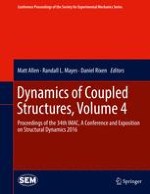Dynamics of Coupled Structures, Volume 4. Proceedings of the 34th IMAC, A Conference and Exposition on Dynamics of Multiphysical Systems: From Active Materials to Vibroacoustics, 2016, the fourth volume of ten from the Conference brings together contributions to this important area of research and engineering. Th e collection presents early findings and case studies on fundamental and applied aspects of Structural Dynamics, including papers on:
• Experimental Dynamic Substructuring
• Structural Coupling of Nonlinear Structures
• Analytical/Numerical Modeling of Joints
• Industrial Applications of Substructuring
• Source Identifi cation & Transfer Path Analysis
• Human Induced Vibrations
• Damping & Friction
